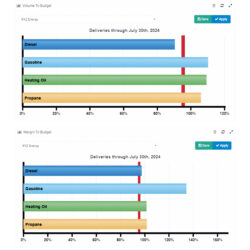Sleep Easy this Heating Season
As summer begins to fade, fuel distribution companies gear up for their busiest time of year. After a slower season, there’s a buzz of excitement as business picks up and revenue starts flowing. But along with the anticipation comes the inevitable worry: What if this season doesn’t go as planned?
If you’re in the fuel business, these concerns probably sound familiar:
- What if the weather stays warm longer than expected?
- What if there are more fuel runouts than usual this fall?
- Will my seasonal drivers return, and do I even need them all?
The list goes on, and it can be overwhelming. But instead of losing sleep over these uncertainties, there are steps you can take to minimize the risks and improve your chances for a successful heating season.
Tackling Excessive Service Calls Before They Begin

Example of an “Excess Calls Report”
The first cold snap of the season often triggers a wave of customer service calls. While some level of reactive work is unavoidable, it doesn’t have to be the default mode. In fact, your business already holds the data you need to get ahead of the curve.
Take a look at your business operating system (BOS). By analyzing service call frequency, you can identify customers who may have unrealistic expectations, equipment that’s due for upgrades, or even service technicians who may not be performing as well as they should. Creating an “excess calls report” can help you pinpoint problem areas before they escalate.
This proactive approach not only reduces the stress of those early-season service calls but also improves customer satisfaction and operational efficiency.
Setting Liquid Product Goals: A Blueprint for Success

Example: Liquid Production Goals
One of the keys to thriving in the heating season is having clear, measurable goals. Whether your focus is on total gallons delivered, profit margins, or product mix, setting up a budget at the start of the season can make all the difference.
Rather than waiting until it’s too late to change course, establish monthly targets for both volume and margin.
Review these figures weekly in the early part of the season and increase the frequency to twice a week from December onward. This allows you to spot any deviations early and adjust accordingly, avoiding any unpleasant surprises down the road.
Additional Concerns to Consider
To ensure smooth operations, there are a few more areas that deserve your attention:
- Tracking Margins Accurately: Make sure you’re inputting bill-of-ladings properly, differentiating between contracted and non-contracted supplier bills, and keeping inventory movements in order.
- Boosting Delivery Efficiency: Regularly review your delivery data, including delivery sizes and how they align with forecasts. Small tweaks here can add up to big savings over time.
- Baseline Data Accuracy: Key operational metrics like miles driven and hours worked are often overlooked, but they’re essential for accurate cost calculations. Keep a close eye on these to ensure you’re working as efficiently as possible.
Plan Now, Sleep Better Later
While this time of year can feel stressful, it’s also an opportunity to identify and address potential problems before they spiral out of control. Most fuel distribution companies share common concerns, but the level of concern varies depending on how prepared you are. By proactively addressing key issues, you can set yourself up for a more successful and less stressful heating season.
At Angus Energy, we specialize in helping fuel distribution companies optimize their operations and meet their goals. If you’re ready to get ahead of the curve, we’re here to help. Reach out to us today, and let’s make this heating season one you can feel confident about.
 The above is a version of the article “What Keeps You Up at Night?” written by Philip J. Baratz.
The above is a version of the article “What Keeps You Up at Night?” written by Philip J. Baratz.
Original article published in the September/October 2024 issue of Indoor Comfort Marketing.
Want to be notified about new articles, blog posts, and/or upcoming events?
Sign up to receive our Featured Content email messages.

